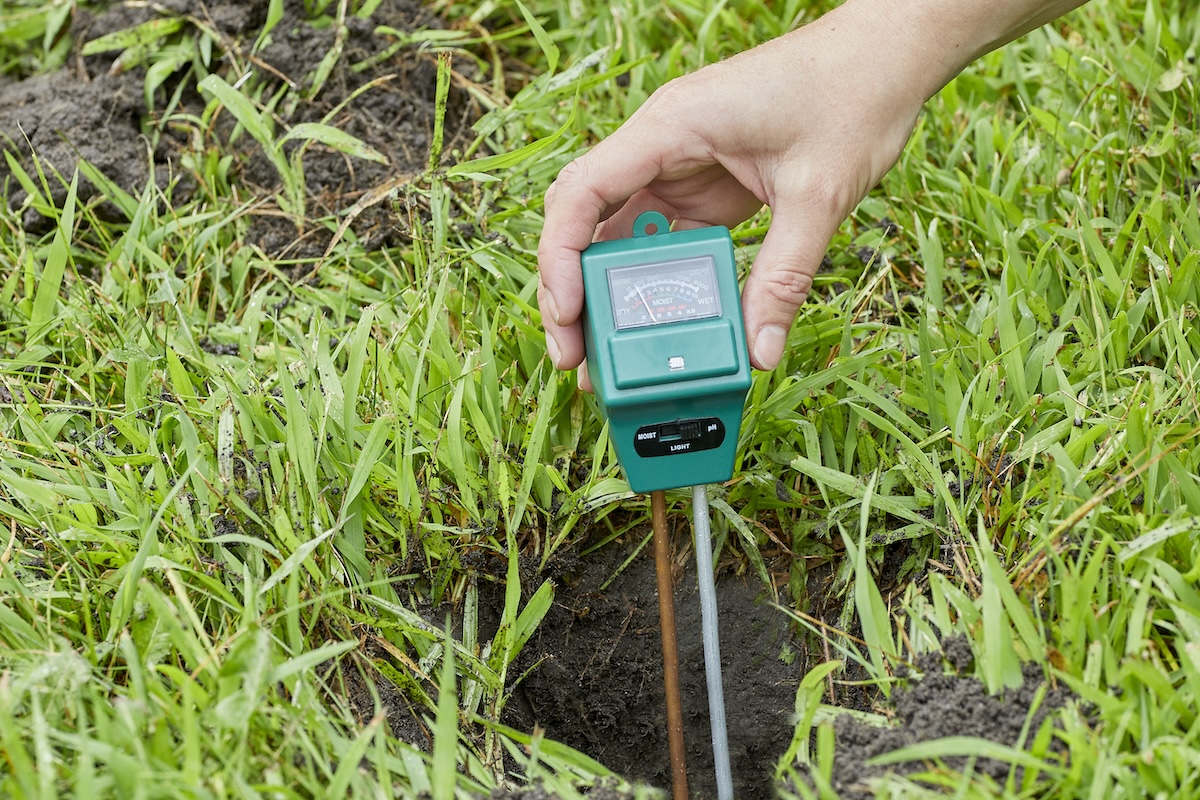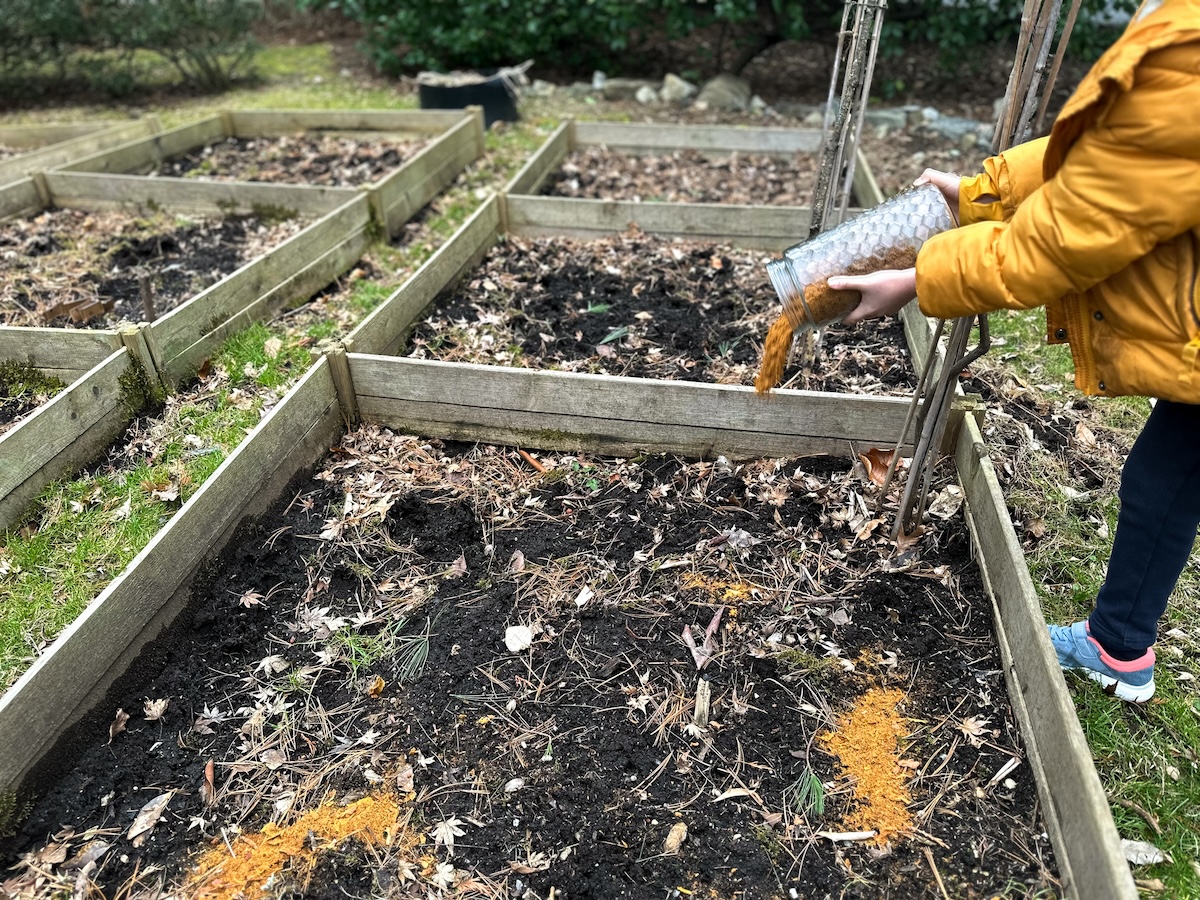Achieving a lush lawn or a thriving flower bed takes more than watering at the right times or planting in the right spot. Knowing the pH of the soil in your lawn and vegetable and ornamental gardens can be key. This number between 0 and 14 can be the difference between nutrient-dense soil that fosters growth (resulting in healthy and happy plants), and poor soil that can be inhospitable to plant life.
Soil pH is a measurement of the concentration of hydrogen ions in the soil; the abbreviation “pH” stands for “potential hydrogen.” The more hydrogen ions in the soil, the higher the soil’s pH.
Most soils have a pH value somewhere between 3.5 and 10. Usually, soil is considered neutral if it has a pH value of 7. If the pH registers higher than 7.5, the soil is considered alkaline. Less than 7 on the pH scale means you have acidic soil.
Though pH values in soil largely result from “the kinds of parent materials from which the soil was formed,” according to Clemson Cooperative Extension, other factors you can’t control (like rainfall or lack of rain) can affect pH. You can, however, help add organic matter or apply soil amendments and fertilizer to decrease soil pH.
How pH Levels Affect Plant Growth
When soil pH is neutral to slightly high (7.5), most vegetables and ornamental plants can grow fine, although it helps to know how to lower soil pH slightly for acid-loving plants. But soil that is alkaline (higher than 7.5) often lacks nutrients or makes most nutrients in the soil less available for plants. In particular, phosphorus, which is one of the macronutrients plants need for healthy root formation and flower or fruit production, is unavailable to plants in alkaline soil.
Most micronutrients and minerals like calcium, iron, zinc, and magnesium, also are absent, leading to several nutrient deficiencies. A common sign of high pH in soil is leaves turning pale green or yellow, which signals an iron deficiency.
Why You Should Lower pH Levels
If your vegetable garden soil, for example, tends toward neutral (6.5 to 7), you probably don’t need to lower your soil pH, assuming you get typical rain for your area in the next few seasons. However, if you live in a region with highly alkaline soils and little rain (think desert!), knowing how to lower the pH level in soil is essential and is an ongoing garden or lawn task.
Lower pH to grow specific plants.
Plants that prefer more acidic soil will need help growing in soil with a pH of 7.0 or higher. Even if you live in a region with mostly neutral soil pH, take steps to learn how to reduce soil pH enough to support acid-loving plants. See this list from the University of Connecticut for more plants’ soil pH scale targets.
Target pH Levels for Selected Plants
Most vegetable crops (including tomatoes) fare best at a mostly neutral pH of 6.5. Those listed in the first chart below like slightly lower pH. Likewise, the trees, perennials, and shrubs in the second chart prefer acidic soils.
| Vegetables and fruits | |
|---|---|
| Beans (lima) | 6.0 to 6.2 |
| Blackberries | 5.0 to 6.0 |
| Blueberries | 4.5 to 5.5 |
| Carrots | 5.6 to 6.0 |
| Sweet Potatoes | 5.6 to 6.2 |
| Watermelon | 5.6 tp 6.2 |
| Perennials, shrubs, and trees | |
|---|---|
| Ajuba | 4.0 to 6.0 |
| Azalea | 4.5 to 6.0 |
| Coreopsis | 5.0 to 6.0 |
| Hydrangea (blue) | 4.0 to 5.0 |
| Laurel | 5.0 |
| Magnolia | 5.0 to 6.0 |
| Rhododendron | 4.5 to 6.0 |
| Spruce | 4.0 to 5.0 |
Lower pH in regions with alkaline soils.
If you live on the coast or areas that receive lots of rain, your soil often is acidic. But many parts of the Middle and Western United States have highly alkaline soils. Centuries of low rainfall and little organic matter make growing anything other than native plants a challenge. Regularly amending soil and adding organic matter to lower pH naturally can help plants to grow in it, but you still must be selective about what you choose to grow.
If you really want blueberries, for example, grow them in a container or raised bed filled with potting mix that supports neutral to acid-loving plants. Simply adding acid amendments to the planting hole won’t support an acid-preferring plant over time if it sits in high-pH soil. Commercial potting soil for container growing usually has a neutral pH, so lowering the soil’s pH levels usually isn’t a concern if you are growing most plants in containers.
When You Should Lower Soil pH Levels
Highly alkaline soil might need frequent and calculated amending to grow even common vegetables and acid-loving plants. The best time to amend soil to change soil pH is well before planting, preferably a year. Once plants are in the ground, working amendments into the soil can disturb the plants’ roots. Optimally, amend alkaline soil in annual and vegetable gardens a year before planting, or each fall after plants are done with harvest. Check soil pH about 6 months after amending or at least a month before spring planting; this should be done before sowing seeds or putting in new plants.
Local extension offices and product labels can provide formulas for the amount of amendment to add, and often recommend spreading applications over time. Don’t add all of an amendment at once in established beds. Instead, add a portion of the recommended amount monthly until you’ve reached the recommended total. If possible, check pH every 3 months during the growing season.
Before You Begin
Ask your local cooperative extension office or master gardeners about typical soil pH levels in your geographic area as a general guide. Soil testing is the only sure way to reveal the exact pH level of your garden’s soil.
Lowering soil pH takes patience, so don’t expect to see immediate changes. Follow the steps below to improve soil pH gradually and to help plants grow in alkaline soil.
Tips and Safety Considerations for Lowering Soil pH
- Use gloves, eye protection, and a mask when applying any soil amendment or fertilizer to avoid health hazards or injury.
- Apply products on days with mild weather and no wind.
- Keep pets and children away from the area to avoid accidental ingestion or exposure.
- Follow manufacturer directions for application, including the specific ratio of product to use.
- Amend soil before planting (preferably at least a month ahead).
An important note: When searching for how to make soil acidic naturally and lower soil pH, some sites may tout sulfuric acid because it is fast-acting. However, it is considered an unsafe practice for home gardeners; sulfuric acid is a corrosive substance.
How to Lower Soil pH With Sulfur
Adding sulfur to soil is the best way to try to lower pH in soil quickly. Sulfur is a natural element that occurs in decaying organic matter. Several types of sulfur are available as garden soil amendments. The two most common additives to help drop pH in soil are elemental sulfur and aluminum sulfate.
Both sulfurs usually include chemical, or synthetic, elements. Elemental sulfur is safer to use, but slower to react. How quickly either amendment works and how much to apply also depends on soil makeup; Iowa State University offers a calculator to help you plan.
- Elemental sulfur is economical, and a good choice for dense clay soil and large planting areas, such as new lawns or vegetable gardens.
- Aluminum sulfate for plants is a quicker-acting option because it is water-soluble and dissolves instantly where moisture is present. It is not as economical as elemental sulfur but works well in sandy soils if applied regularly.
Step 1: Identify plants’ soil pH requirements.
Before deciding how to adjust pH in soil, evaluate what will grow there, since different types of plants have different soil pH level requirements. Know the preferred pH of the grass, ornamental, edible, or shrub that you want to plant. A native garden or grass likely has different pH requirements than a vegetable garden or non-native flowering shrub, for example.
Step 2: Test the soil’s pH level.

If you are not sure how to test soil pH, you may find that the easiest way to do so is with a home soil test kit. Many pH meters include soil pH levels, though they are not as accurate as soil tests. For the most complete results on pH and soil nutrients, contact your county extension office to learn about mail-in soil tests. Meters, kits, or test results will show a pH number. If the pH level is above 7.5, then the soil’s pH will need to be lowered to ensure that most plants can thrive, especially any that prefer more acidic conditions.
Step 3: Add sulfur to soil.
Ideally, add sulfur to the soil a year before planting in new lawns or beds to give the additive time to work. Package directions and local extension offices can help you calculate the amount to use based on the current pH, climate, and type of plant you are growing. In addition, add organic plant mulch or composted manure to enrich alkaline soil when prepping beds for growing in fall or spring. As these organic materials break down, they can help lower pH over time and add important nutrients often lacking in alkaline soil.
In established garden beds, top dress with sulfur and gently work it into the top inch or two of soil. In lawns or beds with plants, opt on the low side of the recommended amount to prevent burning grass or plants or apply in portions every month or so. Too much sulfur or fertilizer can harm nearby plants, so it’s crucial to follow the manufacturer’s recommendations when adding sulfur to lower soil pH.
Top-dressing will not change soil pH, but will help provide temporary drops in pH level to help existing plants take up nutrients. On established lawns, use a spreader to apply the product evenly over the lawn in a thin layer. Water about 30 minutes after applying.
Step 4: Work sulfur into soil with a shovel or hoe.
To ensure the additive mixes with the existing soil before planting, incorporate it with a shovel or hoe. Ideally, turn the soil so that the sulfur reaches a depth of 6 to 8 inches. In new or empty planting areas, you can temporarily remove the top layer of soil, distribute the sulfur, and then return the topsoil and mix it with the shovel, or simply dig and flip the top 6 inches of soil to work the sulfur in.
If you plan to add organic matter, you can do so at the same time, working it a few inches down as well. Again, if an area of your garden has established plants growing, sprinkle the sulfur and some compost on top of the soil and gently work it in with a hand trowel.
Step 5: Water the soil.
Water helps encourage microbial activity in existing soil and added compost. It also can help settle the added sulfur, especially if sprinkled on lawns or top-dressed in mature beds. Water thoroughly about 30 minutes after applying sulfur.
Step 6: Wait a month to plant.
Wait at least a month after adding sulfur to plant in a garden bed, since sulfur can burn plant roots. It also takes weeks to months to lower pH, depending on the soil type or composition and product used.
How to Maintain Soil pH and Plant Health

Now that you know how to lower pH in soil, maintain lower levels and plant nutrients as best you can. Well-balanced fertilizers can help maintain soil pH and make nutrients available to plants in highly alkaline soils. These fertilizers contain a balance of ingredients, such as what’s found in a product with 10-10-10 NPK (nitrogen, phosphorus, and potassium) values. Fertilizers like ammonium sulfate and urea contain nitrogen, which can lower pH.
One of the best things to do for garden soil is to incorporate organic materials that break down slowly over time, which can lower soil pH naturally. Natural organic matter adds micronutrients and helps maintain pH balance in the soil. These can include peat moss or mulch with pine needles or other acidic plant materials. Additionally, adding composted manure to the soil is a great way to lower the soil pH while also providing immediate nutrients for the plants and making the soil more workable.
Continue to test your soil every 3 years, or if you make a dramatic change in plant selection. Taking a soil sample also helps identify problems with plant health and nutrient deficiencies in soil.
FAQs
The cheapest way to lower soil pH is using elemental sulfur; however, it can take a long time (several months to a year) to adequately break down enough in the soil for planting.
Coffee grounds do contain compounds that make soil healthy, mainly carbon and nitrogen, but they do not contain enough acidity to effectively lower soil pH significantly.
Vinegar does not permanently lower soil pH. Vinegar only changes the pH of the water in the soil and not the mineral portion, so once regular water or rain is introduced, the vinegar is essentially rendered nonexistent.
When soil pH is too high, plants have difficulty absorbing nutrients from the soil. This inhibits plant growth and often manifests in leaf discoloration and yellowing as well as brown spots and other problems.
The best way to lower the pH of the soil is by using a soil additive such as elemental sulfur or aluminum sulfate in conjunction with mulch, manure, and other organic ingredients that slowly break down over time, creating a sustained lower pH level. Ammonium-containing nitrogen fertilizers, such as ammonium sulfate or urea, can also help maintain the acidity levels in soil, but the use of these fertilizers exclusively will not significantly lower the soil’s pH levels enough on their own.
No, Epsom salt has a neutral pH value and will not lower the pH in soil (nor will it increase it).


